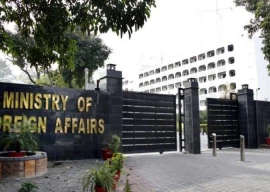
The monsoon clouds are menacing, ominous, casting a gloomy shadow on the fields below and leaving massive devastation in their wake.
Reports of inundated villages, washed away katcha homes and destroyed crops gain momentum as the system travels up north, with torrential rains having battered lower Sindh, lashing upper Sindh and south Punjab and keeping central and upper Punjab on its edge. Flash floods have also been reported across eastern Balochistan.
Looting trucks, blocking roads in lower Sindh
Five days of downpours have killed more than 60 in lower Sindh, besides pervasive crop devastation, loss of livestock and collapse of thousands of katcha houses.
Eight deaths were reported on Saturday as heavy rains continued to lash Nawabshah, Dadu, Matiari, Sanghar, Mirpurkhas, Tando Allahyar, Naushehro Feroze, Badin, Umerkot and Tando Muhammad Khan districts.
Badin, one of the worst-hit districts, witnessed looting of trucks carrying relief goods. Six women were injured when the police resorted to baton charge to disperse the crowd.
Separately, the National Highway was blocked by enraged locals for several hours in Nawabshah district.
“Rains have completely destroyed the standing crops in Tando Muhammad Khan,” said Federal Minister for Water and Power Syed Navid Qamar, who is elected from that district.
Although the agriculture department has not issued the details of crop losses but it is believed that rains have destroyed cotton crop sown over 1 million acres in the thirteen rain affected districts of lower Sindh.
The met department has forecast 3 more days of heavy rainfall in Hyderabad and Mirpurkhas divisions.
Torrents flowing off hills in upper Sindh
At least eleven people were killed and hundreds injured as rains lashed upper Sindh, inundating villages, washing away katcha houses and rendering thousands homeless.
The devastating late monsoon rains, starting on the eve of August 30, have also destroyed the standing cotton crop, paddy, sugarcane and vegetables over thousands of acres.
While Khairpur stands drenched as the most affected district in upper Sindh, the monsoons have wreaked havoc across the region, including Sukkur, Rohri, Pannu Aquil, Ghotki, Mirpur Mathelo, Ubauro, Daharki, Jacobabad, Kashmore, Shikarpur, Khairpur and Naushehro Feroze.
With over 2,000 katcha houses washed away and three to four feet high water in its fields, Nara taluka of district Khairpur is purportedly the worst affected.
Torrents flowing off hills have washed away hundreds of villages, said a revenue official from Nara taluka, Iqbal Ahmed Jandan, while talking to The Express Tribune.
While rain destroyed thousands of acres of paddy fields in Kashmore district, the fields in Jacobabad, Shikarpur and Larkana districts would benefit from the rains because crop was sown late in those districts, said general secretary Sindh Abadgar Board G M Khoso while talking to The Express Tribune.
Punjab largely spared, until now
Punjab has fared better than Sindh with three reported deaths and 6,196 displaced in flash floods during the last two months.
According to details from the PDMA, 32 villages have been affected so far while Mianwali, Khushab, Toba Tek Singh, Kasur and Sahiwal are the worst-affected cities.
While PDMA officials claimed that most of Southern Punjab has been largely spared, politicians from the area including MNA Jamshed Dasti and Dr Saeed Buzdar said that hundreds were displaced in Muzaffargarh and DG Khan when Indus and Chenab rivers swelled a few weeks ago. The Punjab government has not provided adequate funds for the strengthening of embankments on rivers and on canals, they said.
Meanwhile, Pakistan Peoples Party MPA from Rajanpur, Ather Khan Gorchani, told The Express Tribune that hill torrents in DG Khan and in Rajanpur have caused massive devastation in the area.
Director met department Muhammad Ajmal Shad said that more rains are expected, particularly in south Punjab and interior Sindh, before the system moves to central and upper Punjab where it would stay for five more days. The monsoon season would end by mid-October, he said.
At present, around 30,000 cusecs of water is flowing in Sutlej River while another 250,000 cusecs is flowing in Indus River, he said, adding that both Mangla and Tarbela dams have been filled to capacity.
Flash floods in Balochistan
Torrential rains have left nine people dead across Balochistan, said director-general provincial disaster management authority (PDMA), Tahir Munir Minhas, while addressing a news conference in Quetta on Saturday.
Kalat, Khuzdar and Loralai are the worst-affected districts, he said, adding that 12 trucks carrying relief goods and medicine have been dispatched so far.
Breaches in the outfall drain inundated 13 villages in Jaffarabad, wreaking havoc on the standing crops and fertile fields. The worst is not yet over, though. Around 56,000 cusecs of water passing through Nari River in Sibi could devastate the plains of Kachhi if the water level continues to rise.
Published in The Express Tribune, September 4th, 2011.



1732883922-0/diddy-(48)1732883922-0-165x106.webp)


1730379446-0/WhatsApp-Image-2024-10-31-at-17-56-13-(1)1730379446-0-270x192.webp)
1732864055-0/Express-Tribune-(1)1732864055-0-270x192.webp)


1732870002-0/BeFunk_§_]__-(73)1732870002-0.jpg)






COMMENTS
Comments are moderated and generally will be posted if they are on-topic and not abusive.
For more information, please see our Comments FAQ